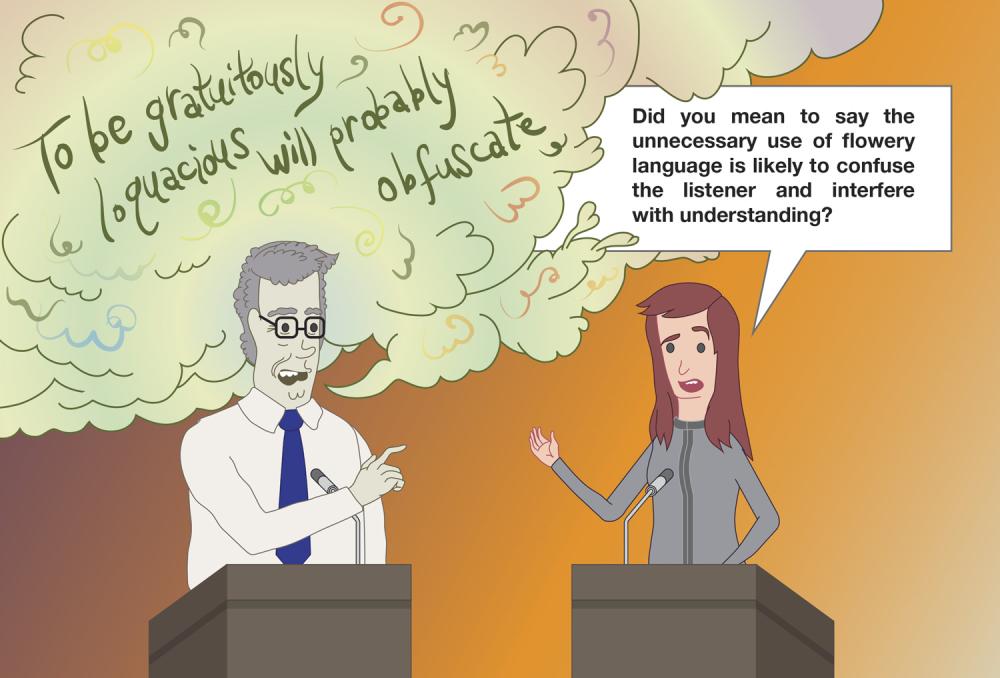To be gratuitously loquacious will probably obfuscate.
Huh? Oh, sorry. Let me try that again. The unnecessary use of flowery language is likely to confuse the listener and interfere with understanding.
Was that dumbing the message down? I don’t think so—it took a few more words, but it was probably clearer.
Alan Greenspan, the well-known American economist who served as chairman of the Federal Reserve of the United States from 1987 to 2006, was somewhat famous for long, meandering sentences fortified with multi-syllabic terminology. I often listened to him “explaining” his actions during news broadcasts that left me wondering what he had just said. To my relief, the news commentators on those broadcasts sometimes also wondered aloud what he’d meant.
An example from a May 2005 speech: “Two years ago at this conference I argued that the growing array of derivatives and the related application of more-sophisticated methods for measuring and managing risks had been key factors underlying the remarkable resilience of the banking system, which had recently shrugged off severe shocks to the economy and the financial system. At the same time, I indicated some concerns about the risks associated with derivatives, including the risks posed by concentration in certain derivatives markets, notably the over-the-counter (OTC) markets for U.S. dollar interest rate options.”
Is that understandable? That first sentence has 54 words, 39 of which are of six letters or more. Even in print I’ve read it several times, and I still don’t quite get it. Granted, there’s some jargon there that might be commonplace for the audience, but if I’d been in the audience that heard it spoken, I certainly would not have understood his point.
Did Greenspan intentionally use flowery words and complicated phrases and sentences? Perhaps. My favorite of all Greenspan quotes (very likely uttered with tongue in cheek) is: “If I turn out to be particularly clear, you've probably misunderstood what I've said.”*
I personally am a great fan of Abraham Lincoln’s Gettysburg Address of 1863, judged by many to be the greatest speech in American history. Delivered in less than two minutes, this powerful speech that defined American freedom in a mere 272 words, 210 of them with five letters or fewer. And it was clearly understood by those who heard it. Lincoln was a master at expressing powerful ideas with plain language.
The simple fact is that, especially when spoken out loud, flowery language often creates a momentary interruption to the flow of the message as the listener’s brain interprets the wording used. I think of excessive use of “ten dollar words” as speed bumps in the road to understanding.
But I’m not the only one who thinks this way. NIH is in agreement, to the extent that the use of plain language is not only encouraged, but rewarded with its annual Plain Language Award competition. NIH even has a website devoted to plain language that provides the following definition:
Plain language is grammatically correct language that includes complete sentence structure and accurate word usage. Plain language is not unprofessional writing or a method of “dumbing down” or “talking down” to the reader.
Writing that is clear and to the point helps improve communication and takes less time to read and understand. Clear writing tells the reader exactly what the reader needs to know without using unnecessary words or expressions.
The Plain Language website also includes links to training, resources, and other important information related to plain language.
The use of simple language, therefore, should not be considered dumbing down your material. Whether you’re speaking or writing, if it helps your audience understand what you’re telling them, using plain language is, in fact, “smartening up” your material.
*www.Brainyquote.com/quotes/authors/a/alan_greenspan.html
© 2015 Ken Michaels, All rights reserved.
Ken Michaels, retired manager of Visual Communications, Leidos Biomedical Research, is a special volunteer for NCI at Frederick.


